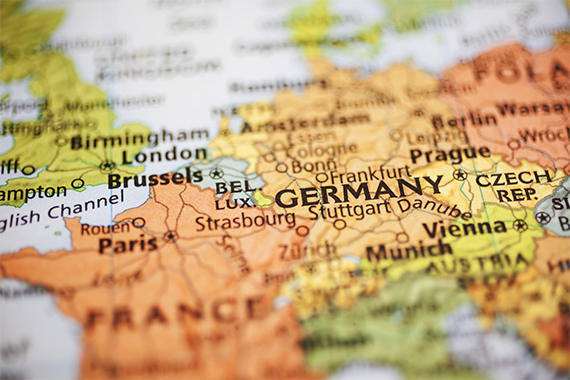
By Jens Kastner, in Hamburg
The newest data released by the German Paint and Printing Ink Association (VdL) shows the fortunes of the German coatings sector were, in 2021, closely tied to the COVID-19 pandemic and increasing price of raw materials globally – causing weak short-term growth and an anticipated contraction in 2023. While the sales volume of construction paints and print inks dropped by 4% and 10% yr-on-yr respectively, that for industrial coatings grew by only 2%, said the VdL (Verband der deutschen Lack- und Druckfarbenindustrie), with total paints, coatings and inks sales volumes falling 5%. However, rising sales prices made imports and exports grow by 12.5% and 13.7% by value, to €1.3bn and €3.8bn respectively [1].
US-based Sun Chemical, a producer of packaging and graphic solutions, colour and display technologies, functional products, electronic materials and chemical products for the automotive and healthcare industries, told PPCJ that the German coatings market is particularly influenced by automotive, construction and industrial applications. Sun Chemical therefore expects its German coatings business to track shifts in GDP. That means stagnation – Germany’s GDP is forecast to decline by 0.6% in 2023 before recovering by 1.4% in 2024, according to the European Commission [2].
Such instability reflects the experience of the German paint and coating sector since the outbreak of COVID-19 in 2020, said Sun Chemical Global Business Manager for Architectural and Industrial Coatings Jana Heiler. She noted that during the last economic upswing early last year following the easing of COVID-19 restrictions, Sun Chemical saw a strong increase in German demand, especially in the architectural sector, driven by DIY home renovation and a revived construction industry. At the same time, Sun Chemical experienced serious supply chain interruptions along the entire value chain as well as a workforce shortage. This has led to a high volume of backorders. “In some sectors, like the automotive industry, we perceive the stepwise production of still-pending orders as a stabilising factor in a worsening market sentiment, while in other sectors, like architectural coatings, the economic and political insecurity and especially the tremendous price increase for energy and raw materials in Europe has led to a serious drop in demand in the second half of 2022,” said Heiler.
“In line with the general economic expectations for the upcoming year, we expect a weak start into 2023, and in order to be well prepared for the upswing after the recession, a close collaboration between customers, suppliers and logistics providers will be crucial,” she added [3].
Precarious situation
Talking to PPCJ, Anne Thüsing, Head of Communications for the Verband der Mineralfarbenindustrie (VdMi), the German association of producers of pigments and fillers, said that VdMi member companies are currently struggling with the energy crisis and associated upward pressures on energy and raw material prices. In parallel, she observed a decline in customer demand, because of this inflation, which was 8.6% in December (2022).
Despite this precarious situation, the European Commission is preparing a flood of ambitious regulatory changes, pushing ahead with the environmental policy priorities under its German President Ursula von der Leyen. This includes reviews of the EU’s chemical regulations REACH and CLP (classification, labelling and packaging), part of this Commission’s overarching aim of making the European Union (EU) have net-zero greenhouse gas emissions by 2050.
Thüsing has concerns: “A looming tightening of the [EU] industrial emissions directive, for its part, will create a range of new stipulations and bureaucratic hurdles for industrial plants, which will further slow approval processes for industrial plants that are already unbelievably slow, especially in Germany,” she added [4].
More positive outlook for automotive and industrial coatings suppliers
Nevertheless, UK-based market researchers Frost & Sullivan highlighted in a note that as the major hub for Europe’s automotive and transportation industry, Germany is witnessing several new international takeovers and manufacturing plant set-ups and expansion of existing manufacturing facilities regarding automotive and industrial coatings suppliers. In April 2022 US-based Sherwin-Williams acquired the European industrial coatings business of Switzerland’s Sika AG, which has Germany-based coatings manufacturing plants. Sherwin-Williams also last June (2022) announced plans to buy Mannheim-based industrial coatings manufacturer and distributer Gross & Perthun.
A prominent driver of capacity growth in Germany is PPG, which significantly expanded its German position during the past three years with the acquisition of three leading Germany-based original equipment manufacturer (OEM) coatings manufacturers – Wörwag (completed in May 2021); Cetelon (completed in April 2021); and Hemmelrath, (completed in 2019).
In January 2022, PPG announced it will invest more than US$10M (€9M) to expand production of automotive coatings at its site in Weingarten, Baden-Württemberg. In December 2021, PPG announced the start-up of expanded automotive OEM clearcoat production at its facility in Erlenbach, also in Baden-Württemberg. The €3M project nearly doubles the site’s capacity for premium clearcoats and uses advanced manufacturing technology to improve operational efficiency, sustainability and flexibility compared to conventional processes. In November 2021 PPG announced the official inauguration of its Packaging Coatings Innovation Centre, Europe in Bodelshausen, again in Baden-Württemberg.
“Germany is a hugely important part of PPG’s manufacturing and R&D footprint, with 13 sites and more than 2200 employees,” Roald Johannsen, PPG Vice President, Automotive Coatings, Europe, Middle East and Africa, told PPCJ.
“It is also a very important end market for PPG, particularly for the automotive sector, due to the large number of OEM customers. The acquisitions have not only strengthened our position in automotive and automotive parts coatings in Germany, but also in other countries served by those companies such as China,” he added.
References:
1 – https://www.wirsindfarbe.de/pr…
2 – https://economy-finance.ec.eur…




